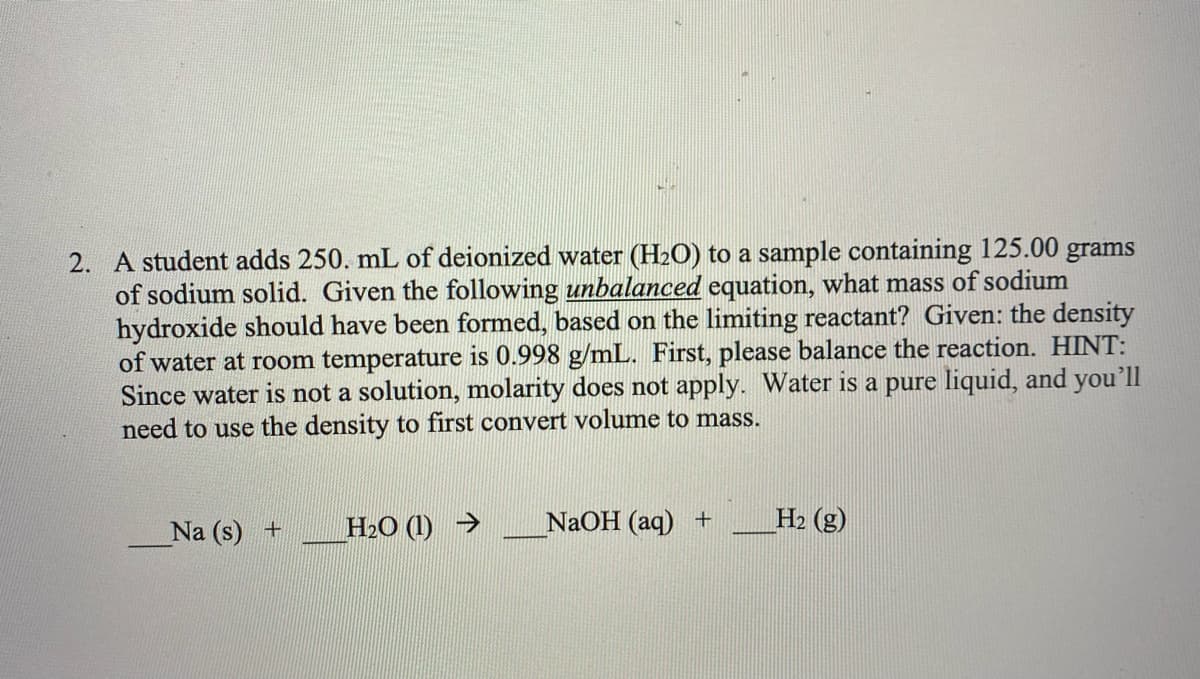2. A student adds 250. mL of deionized water (H2O) to a sample containing 125.00 grams of sodium solid. Given the following unbalanced equation, what mass of sodium hydroxide should have been formed, based on the limiting reactant? Given: the density of water at room temperature is 0.998 g/mL. First, please balance the reaction. HINT: Since water is not a solution, molarity does not apply. Water is a pure liquid, and you'll need to use the density to first convert volume to mass. Na (s) + H2O (1) → NaOH (aq) + H2 (g)
2. A student adds 250. mL of deionized water (H2O) to a sample containing 125.00 grams of sodium solid. Given the following unbalanced equation, what mass of sodium hydroxide should have been formed, based on the limiting reactant? Given: the density of water at room temperature is 0.998 g/mL. First, please balance the reaction. HINT: Since water is not a solution, molarity does not apply. Water is a pure liquid, and you'll need to use the density to first convert volume to mass. Na (s) + H2O (1) → NaOH (aq) + H2 (g)
Introductory Chemistry: An Active Learning Approach
6th Edition
ISBN:9781305079250
Author:Mark S. Cracolice, Ed Peters
Publisher:Mark S. Cracolice, Ed Peters
Chapter10: Quantity Relationships In Chemical Reactions
Section: Chapter Questions
Problem 70E: Classify each of the following statements as true or false: a Coefficients in a chemical equation...
Related questions
Question
Please Help

Transcribed Image Text:2. A student adds 250. mL of deionized water (H2O) to a sample containing 125.00 grams
of sodium solid. Given the following unbalanced equation, what mass of sodium
hydroxide should have been formed, based on the limiting reactant? Given: the density
of water at room temperature is 0.998 g/mL. First, please balance the reaction. HINT:
Since water is not a solution, molarity does not apply. Water is a pure liquid, and you'll
need to use the density to first convert volume to mass.
Na (s) +
H2O (1) →
NaOH (aq) +
H2 (g)
Expert Solution
This question has been solved!
Explore an expertly crafted, step-by-step solution for a thorough understanding of key concepts.
This is a popular solution!
Trending now
This is a popular solution!
Step by step
Solved in 3 steps with 3 images

Knowledge Booster
Learn more about
Need a deep-dive on the concept behind this application? Look no further. Learn more about this topic, chemistry and related others by exploring similar questions and additional content below.Recommended textbooks for you

Introductory Chemistry: An Active Learning Approa…
Chemistry
ISBN:
9781305079250
Author:
Mark S. Cracolice, Ed Peters
Publisher:
Cengage Learning

Principles of Modern Chemistry
Chemistry
ISBN:
9781305079113
Author:
David W. Oxtoby, H. Pat Gillis, Laurie J. Butler
Publisher:
Cengage Learning

Introductory Chemistry: A Foundation
Chemistry
ISBN:
9781337399425
Author:
Steven S. Zumdahl, Donald J. DeCoste
Publisher:
Cengage Learning

Introductory Chemistry: An Active Learning Approa…
Chemistry
ISBN:
9781305079250
Author:
Mark S. Cracolice, Ed Peters
Publisher:
Cengage Learning

Principles of Modern Chemistry
Chemistry
ISBN:
9781305079113
Author:
David W. Oxtoby, H. Pat Gillis, Laurie J. Butler
Publisher:
Cengage Learning

Introductory Chemistry: A Foundation
Chemistry
ISBN:
9781337399425
Author:
Steven S. Zumdahl, Donald J. DeCoste
Publisher:
Cengage Learning

Chemistry: Matter and Change
Chemistry
ISBN:
9780078746376
Author:
Dinah Zike, Laurel Dingrando, Nicholas Hainen, Cheryl Wistrom
Publisher:
Glencoe/McGraw-Hill School Pub Co

World of Chemistry, 3rd edition
Chemistry
ISBN:
9781133109655
Author:
Steven S. Zumdahl, Susan L. Zumdahl, Donald J. DeCoste
Publisher:
Brooks / Cole / Cengage Learning

World of Chemistry
Chemistry
ISBN:
9780618562763
Author:
Steven S. Zumdahl
Publisher:
Houghton Mifflin College Div